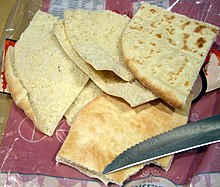
Back خبز عربي Arabic عيش بلدى ARZ Pita Azerbaijani Піта Byelorussian Пита Bulgarian Pita Breton Pita Catalan Pita Czech Bara pita Welsh Pita Danish
 Pita from Greece | |
| Alternative names | Pide, Khubz |
|---|---|
| Type | Flatbread |
| Region or state | Eastern Mediterranean, Middle East[1] |
| Main ingredients | Wheat flour, water, yeast, salt |
Pita (Hebrew: פיתה, Greek: πίτα, romanized: pita /ˈpɪtə/ or US: /ˈpiːtə/)[2] or pitta (British English) is a family of yeast-leavened round flatbreads baked from wheat flour, common in the Mediterranean, Levant, and neighboring areas. It includes the widely known version with an interior pocket, also known as Arabic bread (Arabic: خبز عربي; khubz ʿArabī). In the United Kingdom, Greek bread is used for pocket versions such as the Greek pita, and are used for barbecues as a souvlaki wrap.[3][4][5][1][6][7][8] The Western name pita may sometimes be used to refer to various other types of flatbreads that have different names in their local languages, such as numerous styles of Arab khubz (bread).[9]
- ^ a b Marks, Gil (17 November 2010). Encyclopedia of Jewish Food. HMH. ISBN 978-0-544-18631-6.
- ^ "Pita". Cambridge English Pronouncing Dictionary (18th ed.). Cambridge University Press. 2011.
- ^ Vlachopoulou, Tania (9 October 2024). "How to make easy pita breads for souvlaki (video and photograph)" (in Greek). Archived from the original on 15 November 2024.
- ^ Uvezian, Sonia (2001). Recipes and Remembrances from an Eastern Mediterranean Kitchen: A Culinary Journey Through Syria, Lebanon, and Jordan. Siamanto Press. p. 313. ISBN 978-0-9709716-8-5 – via Google Books.
The best-known bread of the region is khubz arabi (or, simply, khubz), a round, flat, slightly leavened loaf about one-fourth inch thick and with a pocket inside. It is made in three different sizes: large (eight or more inches in diameter), medium (six to eight inches), and small (about five inches). In America, where it has become very popular, this bread is known as pita. A pocketless version is also available. In some Arab communities khubz arabi is called kmaj (from the Persian kumaj), while in others, kmaj refers only to the pocketless type.
- ^ Stewart, Jean E.; Tamaki, Junko Alice (1992). Composition of foods: baked products: raw, processed, prepared. Vol. 8. United States Department of Agriculture, Nutrition Monitoring Division. p. 6. ISBN 978-0-16-038044-0.
Pita bread originated in the Middle East and is also known as Arabic, Syrian, and pocket bread.
- ^ Perry, Charles (21 August 2014). Davidson, Alan (ed.). The Oxford Companion to Food. Oxford University Press. pp. 629–630. ISBN 978-0-19-104072-6 – via Google Books.
- ^ Wright, Clifford A. (2003). Little Foods of the Mediterranean: 500 Fabulous Recipes for Antipasti, Tapas, Hors D'Oeuvre, Meze, and More. Harvard Common Press. p. 61. ISBN 978-1-55832-227-1.
- ^ Roden, Claudia (24 December 2008). The New Book of Middle Eastern Food. Knopf Doubleday Publishing Group. pp. 393–396. ISBN 978-0-307-55856-5 – via Google Books.
- ^ Serna-Saldivar, Sergio O. (2012). Cereal Grains: Laboratory Reference and Procedures Manual. CRC Press. p. 215. ISBN 978-1-4398-5565-2.